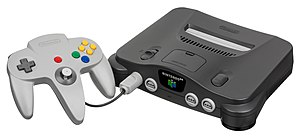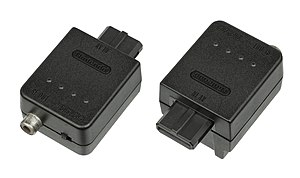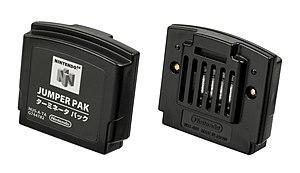Parts and Accessories
This is a list of parts and accessories for the Nintendo 64.
Nintendo 64 (Control Deck)
Nintendo 64 (NUS-001)

Nintendo 64 Control Deck
Pikachu Nintendo 64 (NUS-101)
It is a Nintendo 64 featuring PIKACHU, and size is larger than a the NUS-001. The location of a power lamp moved from the front to the cheek of PIKACHU which is topside. It cannot be used with the 64DD(NUS-010) without modification to the shell as the expansion port door is missing. System color comes in Orange & Yellow and Blue & Yellow.
Control Deck Accessories
Power Supply (NUS-002)
Supplied with the Nintendo 64 Console to provide power to the Control Deck.
RF Modulator (NUS-003)

These accessories allow the Nintendo 64 and model 2 SNES (redesigned after the launch of the Nintendo 64) to hook up to the television through RF. It was primarily intended for customers with older televisions that lack AV cable support. Since the Nintendo 64 and model 2 SNES lack built-in RF compatibility, the modulator acts as a special adapter that plugs into the Nintendo 64's AV port to give the Nintendo 64 RF compatibility. The RF switch itself is identical in every way to the RF switches released for Nintendo's prior systems (the NES and the SNES) and can be interchanged if needed. This set was later re-released for the GameCube to give it RF capability. The cables intended for the GameCube will also work with the Nintendo 64 and SNES.
Jumper Pak (NUS-008)

The Jumper Pak is a filler that plugs into the console's memory expansion port. It serves no functional purpose other than to terminate the RAMBUS bus in the absence of the Expansion Pak. This is functionally equivalent to a continuity RIMM in a RAMBUS motherboard filling the unused RIMM sockets until the user upgrades. Nintendo 64 consoles were shipped with the Jumper Pak included and already installed. Jumper Paks were not sold individually in stores and could only be ordered individually through Nintendo's online store. The system requires the Jumper Pak when the Expansion Pak is not present or else there will be no picture on the TV screen.
RF Switch (NUS-009)

These accessories allow the Nintendo 64 and model 2 SNES (redesigned after the launch of the Nintendo 64) to hook up to the television through RF. It was primarily intended for customers with older televisions that lack AV cable support. Since the Nintendo 64 and model 2 SNES lack built-in RF compatibility, the modulator acts as a special adapter that plugs into the Nintendo 64's AV port to give the Nintendo 64 RF compatibility. The RF switch itself is identical in every way to the RF switches released for Nintendo's prior systems (the NES and the SNES) and can be interchanged if needed. This set was later re-released for the GameCube to give it RF capability. The cables intended for the GameCube will also work with the Nintendo 64 and SNES.
Expansion Pak (NUS-007)

The Expansion Pak consists of 4 MB (megabytes) of random access memory (RAM)—which is RDRAM, the same type of memory used inside the console itself—increasing the Nintendo 64 console's RAM from 4 MB to 8 MB of contiguous main memory. It is installed in a port on top of the console and replaces the pre-installed Jumper Pak, which is simply a RAMBUS terminator. Originally designed to accompany the 64DD disk drive expansion peripheral for its larger multimedia workstation applications, the Expansion Pak was launched separately in Q4 1998 and then bundled with the 64DD's delayed December 1999 Japan launch package. The Expansion Pak was bundled with Donkey Kong 64, and in Japan, the Expansion Pak additionally came bundled with Zelda: Majora's Mask and Perfect Dark, though the games have been also available separately in other regions. It was bundled with an "ejector tool" (NUS-012) meant for removing the original Jumper Pak.
Game developers took advantage of the increased memory in various ways, including greater visual appeal. The Expansion Pak is required in order to run two cartridge games, Donkey Kong 64 and The Legend of Zelda: Majora's Mask; a third game, Perfect Dark, would lack most of its content (such as the single-player campaign) when no Expansion Pak was present, a fact described on the back cover as "approximately 35%" of the game being available in that case, arguably amounting to a mere demo mode. It is also required for all 64DD software. In StarCraft 64, it is needed to unlock levels from the Brood War add-on for the PC version of the game. The Nintendo 64 all-remade version of Quake II features higher color depth and better performance, but not a higher resolution when using the Expansion Pak. Finally, in the vast majority of games with support, such as Castlevania: Legacy of Darkness and Indiana Jones and the Infernal Machine, the expansion Pak is merely used as additional framebuffer memory to enable various high-resolution (usually interlaced) mode options, at the downside of usually worse performance, in some cases dramatically so. This common simple use of the Expansion Pak can be attributed to ease of implementation and the fact that games still mainly targeted the stock N64 configuration; also, the additional RDRAM could not be easily used to circumvent other bottlenecks of the console, such as the small texture cache. Also, the original NTSC release of Space Station Silicon Valley is known to potentially crash in certain places if the Expansion Pak is present.
Jumper Pak Ejector (NUS-012)
The instrument used when taking out Jumper Pak.
Game Paks (cartridges)
Game Pak Cassette (NUS-006)

The Game Pak is the software supply media of the Nintendo 64. It is heavier than the cassette of a SuperFamicom(SNES). Capacity is 64Mbit~512Mbit (8MB~64MB). Data Transfer Rate is 5.3MB/sec
Mario Photopi Cartridge (NUS-023)
It is a Game Pak of "Mario's Photopy". There are two SmartMedia slots. and, The image of the digital camera of SmartMedia can be edited.
- Japan: December 2, 1998 for ¥9800.(Mario's Photopy)
- U.S.: none
- Europe: none.
Nintendo 64 Disk Drive (64DD)
64DD (NUS-010)

The 64DD (short for "Dynamic Drive", and subsequently "Disk Drive") is an official peripheral capable of reading and writing disks. The peripheral was initially announced in 1995, planned for release in 1997, and repeatedly delayed until its release in December 1999. It launched alongside a now defunct online service called Randnet. With nine games released, it was a commercial failure and was consequently never released outside Japan.
64DD Accessories
64DD Disk (NUS-011)


The 64DD Disk is the software supply media of 64DD. It was once called to as "64 Dynamic Data Disk (64DDD or 64DD)". but, "64DD Disk" became a formal name. It is unknown whether it has a meaning called "Dynamic Data". Total Capacity is about 64MB, and rewritable capacity is about 38MB.
64DD All Softwares
- F-ZERO X -EXPANSION KIT- (Released at April 21, 2000 : bundled 64DD Kit)
- Kyojin no Doshin: Kaihou Sensen Chibbikko Chikko Daishuugo (Released at May 18, 2000 for ¥3333)
- Kyojin no Doshin 1 (Released at December 14, 1999 : bundled 64DD)
- SimCity 64 (Released at February 24, 2000 : bundled 64DD Kit)
- Japan Pro Golf Tour 64 (Released at May 2, 2000 for ¥3500)
- Mario Artist: Communication Kit (Released at June 28, 2000 : bundled 64DD Kit)
- Mario Artist: Talent Studio (Released at February 24, 2000 : bundled 64DD Kit)
- Mario Artist: Paint Studio (Released at December 14, 1999 : bundled 64DD Kit)
- Mario Artist: Polygon Studio (Released at August 31, 2000 : bundled 64DD Kit)
- Randnet Disk (Released at February 24, 2000 : bundled 64DD Kit)
Mouse (NUS-017)

The mouse was developed for the 64DD's GUI-based games and applications, such the Mario Artist suite, SimCity 64, and the web browser for Nintendo's defunct online service Randnet. It was manufactured by Mitsumi and bundled with the 64DD's launch game, Mario Artist: Paint Studio. It works with the Game Pak Mario no Photopi.
Capture Cassette (NUS-028)
A video capture cassette for use on the Mario Artist 64DD game series. It can capture composite video with stereo sound and microphone mix. It was bundled with the 64DD game Mario Artist - Talent Studio.
Modem (NUS-029)

A 28.8 kbit/s modem on a Nintendo 64 cartridge, formerly for use with the Randnet service and compatible 64DD games.
Keyboard (RND-001)
An official compact keyboard for use with the Randnet service and compatible 64DD games. Re-licensed by Randnet under Nintendo Licence. Comes with stickers to identify controller buttons.
Nintendo 64 Controller
Controller (NUS-005)

The Nintendo 64 controller is a trident-shaped controller with 10 buttons (A, B, C-Up, C-Down, C-Left, C-Right, L, R, Z, and Start), one analog stick in the center, a digital directional pad on the left side, and an extension port on the back for many of the system's accessories. Initially available in the seven colors of gray, yellow, green, red, blue, purple, and black, and it was later released in translucent versions of those colors except gray.
N64 Controller Accessories
Controller Pak (NUS-004)

The Controller Pak is the console's memory card. Certain games allow saving of game files to the Controller Pak, which plugs into the back of the Nintendo 64 controller (as do the Rumble and Transfer Paks). The Controller Pak was marketed as a way to exchange data with other Nintendo 64 owners, since information saved on the game cartridge can not be transferred between cartridges.
It is plugged into the controller and allows the player to save game progress and configuration. The original models from Nintendo offered 256 kilobits (32KB) battery backed SRAM, split into 123 pages with a limitation of 16 save files, but third party models have much more, often in the form of 4 selectable memory bank of 256kbits. The number of pages that a game occupy vary, sometimes using the entire card. It is powered by a common CR2032 battery.
Upon launch, the Controller Pak was initially useful, and even necessary for the earlier Nintendo 64 games. Over time, the Controller Pak lost popularity to the convenience of a battery backed SRAM or EEPROM found in some cartridges. Because the Nintendo 64 uses a Game Pak cartridge format that allows saving data on the cartridge itself, few first party and second party games use the Controller Pak. The vast majority are from third-party developers. This is most likely due to the increased production and retail costs which would have been caused by including self-contained data on the cartridge. Some games use it to save optional data that is too large for the cartridge, such as Mario Kart 64, which uses 121 of the total 123 pages for storing ghost data, or International Superstar Soccer 64, which uses up the entire cartridge's space for its save data. Tony Hawk's Pro Skater uses 11 pages. Quest 64 and Mystical Ninja Starring Goemon use the Controller Pak exclusively for saved data. The Japan-only game Animal Forest uses the Controller Pak to travel to other towns.
Rumble Pak (NUS-013)

The Rumble Pak is an accessory which provides haptic feedback to the player by way of vibration. It is powered by two AAA batteries and connects to the controller's expansion port. It was released in 1997 for the new game Star Fox 64 or Lylat Wars, with which it was originally bundled.
Transfer Pak (NUS-019)

The Transfer Pak is an accessory that plugs into the controller and allows the Nintendo 64 to transfer data between its own games and Game Boy or Game Boy Color games. The Transfer Pak has a Game Boy Color slot and a part that fits onto the expansion port of the N64 controller. It was included with the game Pokémon Stadium, as the game's main feature is importing Pokémon teams from Game Boy games.
In Japan it is called "64GB" as Shigeru Miyamoto described at Nintendo's Space World 1997 trade show. It was a key feature of the infamous creature raising game prototype that was never released, Cabbage.
Pokémon Stadium and Pokémon Stadium 2 are games that rely heavily on the Transfer Pak. Pokémon Stadium also includes a "GB Tower" mode for playing Pokémon Red, Blue, and Yellow directly on the Nintendo 64 via a built-in Game Boy emulator.
The Japanese version of the Game Boy Camera can be connected to the Mario Artist series. Mario Golf and Mario Tennis make use of the Transfer Pak. Rare's Perfect Dark was initially going to be compatible with the Transfer Pak in order to use pictures taken with the Game Boy Camera to create characters with real-life faces, but this function was removed from development after the attacks at Columbine High School and a wave of anti-violent video game sentiment; the Transfer Pak is usable only in combination with the Game Boy Color version of Perfect Dark for unlocking bonuses.
| Nintendo 64 Game | Game Boy Game(s) | |
|---|---|---|
| Mario Artist: Talent Studio | Game Boy Camera | |
| Mario Golf | Mario Golf | |
| Mario Tennis | Mario Tennis | |
| Mickey's Speedway USA | Mickey's Speedway USA | |
| Perfect Dark | Perfect Dark | |
| Pokémon Stadium | Pokémon: Red & Blue Version
Pokémon: Yellow Version | |
| Pokémon Stadium 2 | Pokémon: Red & Blue Version
Pokémon: Yellow Version Pokémon: Gold & Silver Version Pokémon: Crystal Version |
Voice Recognition Unit (VRU)
Voice Recognition Unit (VRU) (NUS-020)

The VRU (Voice Recognition Unit) is compatible with only two games: Hey You, Pikachu! and Densha de Go! 64. A VRU is included with every factory package of Hey You, Pikachu! and is required to play the game. Densha de Go! 64 does not require the VRU, and as such, they are sold separately. The peripheral consists of a ballast (NUS-020) connected to controller port 4 of the system, a microphone (NUS-021), a yellow foam cover for the microphone, and a clip for clipping the microphone to the controller (NUS-025, bundled with Hey You, Pikachu!) or a plastic neck holder for hands free usage (NUS-022, bundled with Densha de Go! 64). The VRU is calibrated for best recognition of a high-pitched voice, such as a child's voice. As a result, the voices of adults and teenagers are less likely be recognized properly by the VRU.
VRUs are region dependent, and a USA region VRU cannot be used with Japanese games and vice versa (foreign region VRUs are not detected by the games). No VRU compatible game was launched in the EUR region (PAL, Europe), so there is no EUR-region VRU. A similar device was also released for the Wii called the Wii Speak.
VRU Accessories
Microphone (NUS-021)
It is a common Microphone. It is connected to "Voice Recognition Unit(NUS-020)" etc.. It is bundled with Voice Recognition System Unit.
Microphone Holder (NUS-022)
It is the Microphone Holder of the type hung to a neck. It is bundled with Voice Recognition System Unit.
Microphone Strap (NUS-025)
It is the Microphone holder of the type fixed to a controller. It is bundled with Voice Recognition System Unit.
Microphone Foam Ball (NUS-026)
The yellow-cover for the sound of a breath not being taken in by the microphone. It is bundled with Voice Recognition System Unit.
Cleaning Kits
Control Deck Cleaner (NUS-014)
Nintendo released a first party cleaning kit for the Nintendo 64. It contains everything required to clean the connectors of the control deck, controllers, Game Paks, Rumble Paks, and Controller Paks.
Controller Cleaner (NUS-015)
It is inserted instead of a Controller Pak (NUS-004 etc.) and cleans a connector. It's contained in "Cleaning Kit". "Cleaning Kit" was released in foreign countries. not released in Japan.
Cleaning Wand (NUS-016)
It cleans a metal terminal such as Game Pak (NUS-006) and Controller Pak (NUS-004). It's contained in "Cleaning Kit". "Cleaning Kit" was released in foreign countries. not released in Japan.
Unused NUS Codes
??? (NUS-018)
Unknown - Not Used / Unreleased
??? (NUS-024)
Unknown - Not Used / Unreleased
??? (NUS-027)
Unknown - Not Used / Unreleased